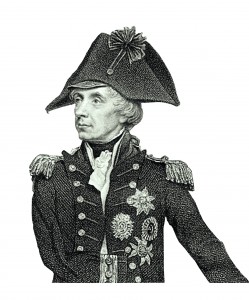Trafalgar Day, 21 October, not only marks one of Admiral Nelson’s great sea victories, in 1805, but also his demise and the beginning of a tradition known as the Immortal Memory – where basically you toast him and his deeds. Without advocating any drunkenness on watch at sea, the proposal to splice the mainbrace to that immortal memory is always a good reason to get a Navy-sized tot inside you!
The traditional spirit, after British dominance of the West Indies in the 17th century, has always been rum and a simple cocktail or long drink for that is the dark and stormy – mixing rum with ginger beer, some sugar syrup and a dash of lime juice. It’s often said Nelson was brought back to Britain from Trafalgar in a barrel of rum and sailors would siphon some off periodically in the hope they imbibed some of his fighting spirit. Charming thought.

Nelson was in good health despite his wounds. He became vegetarian and teetotal to overcome his gout.
The truth of Nelson’s body’s return to Britain is described by Victory’s surgeon Wm Beatty in a report which was published as a book by Cadell and Davies in 1807. As a first-hand account it makes fascinating reading and can be read online at the Project Gutenberg website www.gutenberg.org. Search under Wm Beatty: Death of Nelson.
Beatty describes the days leading up to 21 October 1805 and gives a blow-by-blow account of the day itself, including the electrifying effect Nelson’s message – England Expects Every Many Will Do His Duty – had on the fleet: “It is impossible adequately to describe by any language, the lively emotions excited in the crew of the Victory when this propitious communication was made known to them.”
That signal was given half an hour before the enemy opened fire and soon Beatty was kept busy looking after the wounded. Describing himself in the third person, his account includes the details of Nelson being shot by a French musketeer in the mizzen top of the Redoutable which HMS Victory was alongside “and of course not more than fifteen yards distant from that part of the deck where His Lordship stood.” Beatty then relates Nelson’s final hours including asking Captain Hardy to kiss him (which he does twice) and asking for lemonade (he had been largely a vegetarian teetotaller for two years to overcome gout according to Beatty). “Thus died this matchless hero.”
“Nelson was put into a leaguer, the largest barrel aboard”
Beatty then had the job of getting Nelson’s body back to Britain. The body was put into a 150-gallon water leaguer, the largest barrel carried aboard, filled with brandy – with spirit of wine added in Gibraltar. This was changed several times before the Victory eventually anchored at the Nore (Thames) in December, from where Nelson’s body was taken to Greenwich to lie in state before entombment at St Paul’s cathedral – on January 9 1806. Beatty had disembowelled the body on the way from Portsmouth and discovered the shot, lodged in Nelson’s back. His autopsy notes describe Nelson’s health as remarkable despite his many wounds and he relates Nelson’s friends being amazed at the preserved condition of the body as he lay in state.
A Trafalgar day toast to Nelson would properly follow a loyal toast to The Queen. This respects Nelson’s patriotism.
Nelson sailed before the mast when he was a youth and had logged 45,000 sea miles by the time he was 18. He was grateful for a solid grounding (no pun intended) in seamanship, and said it allowed him to get the better of an enemy at sea under sail. You can about Nelson’s seamanship: HERE
Image is a detail from The Death of Nelson (with Capt Hardy in attendance) the famous wall painting in the Royal Gallery of the Palace of Westminster by Daniel Maclise in 1857. See the full painting: HERE


